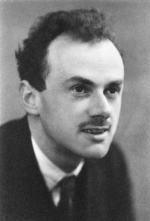 Paul A.M. Dirac was a pioneer of quantum mechanics and quantum field theory. His work pervades all of modern physics. He was, by almost all accounts, one of the top 10 physicists of all time, and by many accounts one of the top 2 physicists of the 20th century. And he’s one of my personal heroes.
Paul A.M. Dirac was a pioneer of quantum mechanics and quantum field theory. His work pervades all of modern physics. He was, by almost all accounts, one of the top 10 physicists of all time, and by many accounts one of the top 2 physicists of the 20th century. And he’s one of my personal heroes.
When Dirac was awarded the Nobel prize in 1933, he was asked to say a few words at the banquet that kicks off the multi-day Nobel celebration — and chose, against tradition, to speak about a subject other than physics. Here is Paul Dirac on the source of all our economic problems:
I should like to suggest to you that the cause of all the economic troubles is that we have an economic system which tries to maintain an equality of value between two things, which it would be better to recognise from the beginning as of unequal value. These two things are the receipt of a certain single payment (say 100 crowns) and the receipt of a regular income (say 3 crowns a year) through all eternity. The course of events is continually showing that the second of these is more highly valued than the first. The shortage of buyers, which the world is suffering from, is readily understood, not as due to people not wishing to obtain possession of goods, but as people being unwilling to part with something which might earn a regular income in exchange for those goods. May I ask you to trace out for yourselves how all the obscurities become clear, if one assumes from the beginning that a regular income is worth incomparably more, in fact infinitely more, in the mathematical sense, than any single payment? In doing so I think you would then get a better insight into the way in which a physical theory is fitted in with the facts than you could get from studying popular books on physics.
True to form, then, Dirac set an agenda that others scurried to follow — the agenda in this case being the exploitation of the Nobel prize as a license to spout economic gibberish. Almost a century later, his program continues to flourish.

